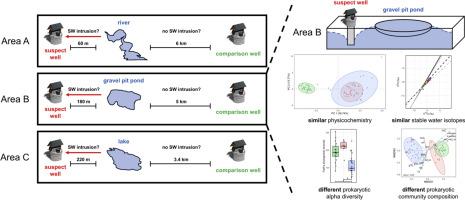井水和入侵地表水之间的物理化学和同位素相似性并不等同于原核生物多样性和群落组成的相似性
IF 11.4
1区 环境科学与生态学
Q1 ENGINEERING, ENVIRONMENTAL
引用次数: 0
摘要
本文章由计算机程序翻译,如有差异,请以英文原文为准。

Physicochemical and isotopic similarity between well water and intruding surface water is not synonymous with similarity in prokaryotic diversity and community composition
Intruding surface water can impact the physicochemical and microbiological quality of groundwater. Understanding these impacts is important because groundwater provides much of the world's potable water, and reduced quality is a potential public health risk. In this study, we monitored six shallow groundwater wells and three surface water bodies in the North Ostrobothnia region of Finland twice monthly for 12 months (October 2021–October 2022) via (i) on-site and off-site measurements of physicochemical water quality parameters, (ii) determination of stable water isotope compositions, and (iii) analysis of microbial communities (via amplicon sequencing of the V3–V4 16S rRNA gene sub-regions). Water from one well showed clear overall physicochemical and isotopic similarity with a nearby pond, as well as temporal fluctuations in water temperature and isotopes that mirrored those of the pond. Isotope mixing analyses suggested that about 80–95% of the well water comes from the pond. Such large-scale intrusion might be expected to reduce prokaryotic diversity and composition in the aquifer, either by strong influx of surface water taxa or changes to aquifer physicochemistry. Compared to the pond, however, prokaryotic communities from the well showed significantly higher alpha diversity and a composition more similar to a nearby well unaffected by intrusion. The finding that physicochemical and isotopic similarity between well water and intruding surface water is not synonymous with similarity in prokaryotic diversity and community composition makes clear the need for a multi-method approach when studying the impact of surface water intrusion on shallow wells.
求助全文
通过发布文献求助,成功后即可免费获取论文全文。
去求助
来源期刊

Water Research
环境科学-工程:环境
CiteScore
20.80
自引率
9.40%
发文量
1307
审稿时长
38 days
期刊介绍:
Water Research, along with its open access companion journal Water Research X, serves as a platform for publishing original research papers covering various aspects of the science and technology related to the anthropogenic water cycle, water quality, and its management worldwide. The audience targeted by the journal comprises biologists, chemical engineers, chemists, civil engineers, environmental engineers, limnologists, and microbiologists. The scope of the journal include:
•Treatment processes for water and wastewaters (municipal, agricultural, industrial, and on-site treatment), including resource recovery and residuals management;
•Urban hydrology including sewer systems, stormwater management, and green infrastructure;
•Drinking water treatment and distribution;
•Potable and non-potable water reuse;
•Sanitation, public health, and risk assessment;
•Anaerobic digestion, solid and hazardous waste management, including source characterization and the effects and control of leachates and gaseous emissions;
•Contaminants (chemical, microbial, anthropogenic particles such as nanoparticles or microplastics) and related water quality sensing, monitoring, fate, and assessment;
•Anthropogenic impacts on inland, tidal, coastal and urban waters, focusing on surface and ground waters, and point and non-point sources of pollution;
•Environmental restoration, linked to surface water, groundwater and groundwater remediation;
•Analysis of the interfaces between sediments and water, and between water and atmosphere, focusing specifically on anthropogenic impacts;
•Mathematical modelling, systems analysis, machine learning, and beneficial use of big data related to the anthropogenic water cycle;
•Socio-economic, policy, and regulations studies.
 求助内容:
求助内容: 应助结果提醒方式:
应助结果提醒方式:


